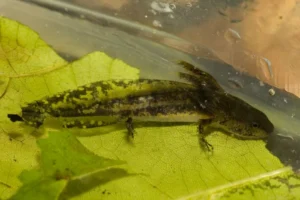Many people who see salamanders in their gardens or near ponds ask an interesting question: do these creatures eat fruit? However, the answer is clear and simple.
Salamanders do not eat fruit. These amphibians are carnivores, which means they eat only meat. Their bodies are built to hunt and eat small animals, not plants or fruit.
Understanding why this is true helps us learn more about how salamanders live and what they need to survive.
The Basic Diet of Salamanders
Salamanders have been meat eaters for millions of years. Their digestive systems work best when they eat protein-rich foods from other animals. Most salamanders prefer to hunt live prey rather than eat dead animals or plants.
The most common foods in a salamander’s diet include insects like crickets, beetles, ants, and flies. These small bugs are easy for salamanders to catch and provide the nutrition they need.

Worms are another favorite food, especially soft earthworms that salamanders can swallow whole.
Salamanders also eat snails and slugs, which move slowly and are easy to catch. Small spiders and other tiny creatures make up another part of their diet.
Some larger salamanders will even eat other amphibians if they can catch them.
The way salamanders catch their food is quite interesting. Most species use their sticky tongues to grab prey quickly. Some salamanders that live mostly in water catch their food by sucking in water along with their prey.
How Salamander Eating Habits Change with Age
Like many animals, salamanders eat different things as they grow up. Each stage of their life requires different types of food.
When salamanders are still eggs, they do not eat anything at all. The egg contains all the nutrition the developing salamander needs to grow.
This stage can last several weeks or even months, depending on the species.
Baby salamanders, called larvae, live in water. They eat very small water animals like water fleas, tiny worms, and other microscopic creatures.
These larvae have gills and cannot survive on land yet.

After metamorphosis, young salamanders can live on land. They start eating bigger prey like small insects and worms. Their diet gradually becomes more varied as they grow.
Adult salamanders eat the widest variety of foods. They can handle larger prey like beetles, moths, and even small fish or mice if they are big enough. However, everything they eat is still animal-based.
Why Salamanders Cannot Eat Fruit
The reason salamanders do not eat fruit has to do with how their bodies work. Their digestive systems are designed specifically for breaking down meat, not plant matter.
Salamanders have simple digestive systems that work well with proteins and fats from animals. These systems cannot handle the complex sugars and fiber found in fruits and other plant materials.
They lack the special enzymes needed to break down plant cell walls and extract nutrients from them.
Salamanders also need specific nutrients that only come from eating other animals. They require high levels of protein to build their muscles and organs.
They also need certain vitamins and minerals that are found in meat but not in fruit.
Another important factor is behavior. Salamanders are natural hunters with instincts that help them find moving prey.
They are attracted to small animals that move around, not to stationary fruits hanging on trees or lying on the ground.
Are There Any Exceptions?
While true salamanders do not eat fruit, some of their close relatives might occasionally eat small amounts of plant material.
Certain types of newts, which are related to salamanders, sometimes eat algae or very small pieces of plants when they eat prey. However, this is not common and is not their main source of food.
Even in these rare cases, fruit is almost never eaten. If plant material is found in a salamander’s stomach, it is usually algae or moss, not fruit.
Sometimes bits of plant matter might be swallowed by accident when a salamander is catching prey.
Scientists have studied salamander diets carefully and have found that fruit consumption is extremely rare.
In most cases where fruit might be found in a salamander’s stomach, it was likely eaten by accident along with an insect or worm.
Feeding Pet Salamanders
People who keep salamanders as pets need to understand their dietary needs. Feeding fruit to a pet salamander can cause serious health problems.
Fruit can upset their digestive systems and lead to malnutrition over time.
Pet salamanders should be fed live insects like crickets, mealworms, or waxworms. Many pet stores sell special amphibian food that is designed to meet their nutritional needs.
Some salamanders will also eat frozen or dried insects, but live food is usually preferred.
It is important to feed pet salamanders the right amount of food. Too much food can make them overweight, while too little can cause malnutrition.
The size and species of the salamander determine how much and how often they should eat.
Conclusion
Salamanders do not eat fruit because their bodies are designed for a carnivorous lifestyle. They are specialized hunters that have evolved over millions of years to catch and eat small animals.
Their digestive systems, behavior, and nutritional needs all point to a diet based entirely on meat.
Understanding what salamanders eat helps us appreciate their role in nature and the importance of protecting their habitats.
These remarkable creatures help maintain the balance of ecosystems by controlling insect populations while serving as food for other animals.

